Digital Reconstruction of Engineered Austenite: Revisiting Effects of Grain Size and Ausforming on Variant Selection of Martensite
Abstract
:1. Introduction
2. Materials and Methods
2.1. Materials and Experimental Procedure
2.2. New PPR Protocol
3. Results
3.1. Effect of Prior Austenite Grain Size
3.2. Effects of Ausforming
4. Discussion
4.1. Effect of Prior Austenite Grain Size on Variant Distribution
4.2. Effect of Ausforming Level on Variant Distribution
5. Conclusions
- The new protocol, modified with boundary voting and solution tuning, greatly improved the quality of the reconstruction.
- Fewer packets tend to form when the grain size of prior austenite is finer, or when large deformation is applied to the austenite.
- When the grain size of the prior austenite is very fine (<20 μm), twinning sub-blocks (e.g., V1 and V2) tend to form at first to compensate for the strain. The insufficient space left by the early transformed martensite causes these two variants to dominate.
- When the applied strain is large (≥50%), the accumulated microbands on the planes act as nucleation sites, at which only variants from the same Bain orientation (e.g., V1 and V4) tend to form.
Author Contributions
Funding
Institutional Review Board Statement
Informed Consent Statement
Data Availability Statement
Acknowledgments
Conflicts of Interest
References
- Bhadeshia, H.K.D.H.; Honeycombe, S.R. 3-The Iron-Carbon Equilibrium Diagram and Plain Carbon Steels. In Steels, 3rd ed.; Butterworth-Heinemann: Oxford, UK, 2006; pp. 39–70. [Google Scholar]
- Nambu, S.; Shibuta, N.; Ojima, M.; Inoue, J.; Koseki, T.; Bhadeshia, H.K.D.H. In situ observations and crystallographic analysis of martensitic transformation in steel. Acta Mater. 2013, 61, 4831–4839. [Google Scholar] [CrossRef]
- Kitahara, H.; Ueji, R.; Tsuji, N.; Minamino, Y. Crystallographic features of lath martensite in low-carbon steel. Acta Mater. 2006, 54, 1279–1288. [Google Scholar] [CrossRef]
- Ray, R.K.; Jonas, J.J. Transformation textures in steels. Int. Mater. Rev. 1990, 35, 1–36. [Google Scholar] [CrossRef]
- Krauss, G. Martensite in steel: Strength and structure. Mater. Sci. Eng. A 1999, 273, 40–57. [Google Scholar] [CrossRef]
- Morito, S.; Yoshida, H.; Maki, T.; Huang, X. Effect of block size on the strength of lath martensite in low carbon steels. Mater. Sci. Eng. A 2006, 438, 237–240. [Google Scholar] [CrossRef]
- Wang, C.; Wang, M.; Shi, J.; Hui, W.; Dong, H. Effect of microstructural refinement on the toughness of low carbon martensitic steel. Scr. Mater. 2008, 58, 492–495. [Google Scholar] [CrossRef]
- Kimura, Y.; Inoue, T.; Yin, F.; Tsuzaki, K. Inverse Temperature Dependence of Toughness in an Ultrafine Grain-Structure Steel. Science 2008, 320, 1057–1060. [Google Scholar] [CrossRef]
- Yen, H.-W.; Chiang, M.-H.; Lin, Y.-C.; Chen, D.; Huang, C.-Y.; Lin, H.-C. High-Temperature Tempered Martensite Embrittlement in Quenched-and-Tempered Offshore Steels. Metals 2017, 7, 253. [Google Scholar] [CrossRef]
- Tsay, L.W.; Lu, H.L.; Chen, C. The effect of grain size and aging on hydrogen embrittlement of a maraging steel. Corros. Sci. 2008, 50, 2506–2511. [Google Scholar] [CrossRef]
- Galindo-Nava, E.I.; Rivera-Díaz-del-Castillo, P.E.J. A model for the microstructure behaviour and strength evolution in lath martensite. Acta Mater. 2015, 98, 81–93. [Google Scholar] [CrossRef] [Green Version]
- Lin, Y.-T.; Yi, H.L.; Chang, Z.Y.; Lin, H.-C.; Yen, H.-W. Role of Vanadium Carbide in Hydrogen Embrittlement of Press-Hardening Steels: Strategy from 1500 MPa to 2000 MPa. Front. Mater. 2020, 7, 432. [Google Scholar]
- He, Y.L.; Godet, S.; Jacques, P.J.; Jonas, J.J. Variant selection during the transformation of deformed austenite in a niobium bearing TRIP steel. In Icotom 14: Textures of Materials, Pts 1 and 2; Houtte, P.V., Kestens, L., Eds.; Trans Tech Publications Ltd: Zurich-Uetikon, Switzerland, 2005; Volume 495–497, pp. 345–350. [Google Scholar]
- Nakada, N.; Tsuchiyama, T.; Takaki, S.; Hashizume, S. Variant selection of reversed austenite in lath martensite. ISIJ Int. 2007, 47, 1527–1532. [Google Scholar] [CrossRef]
- Malet, L.; Barnett, M.R.; Jacques, P.J.; Godet, S. Variant selection during the gamma-to-alpha(b) phase transformation in hot-rolled bainitic TRIP-aided steels. Scr. Mater. 2009, 61, 520–523. [Google Scholar] [CrossRef]
- Miyamoto, G.; Iwata, N.; Takayama, N.; Furuhara, T. Mapping the parent austenite orientation reconstructed from the orientation of martensite by EBSD and its application to ausformed martensite. Acta Mater. 2010, 58, 6393–6403. [Google Scholar] [CrossRef]
- Miyamoto, G.; Iwata, N.; Takayama, N.; Furuhara, T. Quantitative analysis of variant selection in ausformed lath martensite. Acta Mater. 2012, 60, 1139–1148. [Google Scholar] [CrossRef]
- Miyamoto, G.; Iwata, N.; Takayama, N.; Furuhara, T. Variant selection of lath martensite and bainite transformation in low carbon steel by ausforming. J. Alloys Compd. 2013, 577, S528–S532. [Google Scholar] [CrossRef]
- Chiba, T.; Miyamoto, G.; Furuhara, T. Comparison of Variant Selection between Lenticular and Lath Martensite Transformed from Deformed Austenite. ISIJ Int. 2013, 53, 915–919. [Google Scholar] [CrossRef]
- He, J.G.; Du, J.; Zhang, W.Z.; Zhang, C.; Yang, Z.G.; Chen, H. Abnormal Anisotropic Dilatation During Bainitic Transformation of Ausformed Austenite. Metall. Mater. Trans. A Phys. Metall. Mater. Sci. 2019, 50, 540–546. [Google Scholar] [CrossRef]
- Ueda, M.; Yasuda, H.Y.; Umakoshi, Y. Controlling factor for nucleation of martensite at grain boundary in Fe-Ni bicrystals. Acta Mater. 2003, 51, 1007–1017. [Google Scholar] [CrossRef]
- Jafarian, H.; Borhani, E.; Shibata, A.; Tsuji, N. Variant selection of martensite transformation from ultrafine-grained austenite in Fe–Ni–C alloy. J. Alloys Compd. 2013, 577, S668–S672. [Google Scholar] [CrossRef]
- Yen, H.-W.; Ooi, S.W.; Eizadjou, M.; Breen, A.; Huang, C.-Y.; Bhadeshia, H.K.D.H.B.; Ringer, S.P. Role of stress-assisted martensite in the design of strong ultrafine-grained duplex steels. Acta Mater. 2015, 82, 100–114. [Google Scholar] [CrossRef] [Green Version]
- Humbert, M.; Gey, N. The calculation of a parent grain orientation from inherited variants for approximate (b.c.c.-h.c.p.) orientation relations. J. Appl. Crystallogr. 2002, 35, 401–405. [Google Scholar] [CrossRef]
- Cayron, C.; Artaud, B.; Briottet, L. Reconstruction of parent grains from EBSD data. Mater. Charact. 2006, 57, 386–401. [Google Scholar] [CrossRef]
- Cayron, C.; Barcelo, F.; de Carlan, Y. The mechanisms of the fcc-bcc martensitic transformation revealed by pole figures. Acta Mater. 2010, 58, 1395–1402. [Google Scholar] [CrossRef]
- Suikkanen, P.P.; Cayron, C.; DeArdo, A.J.; Karjalainen, L.P. Crystallographic Analysis of Martensite in 0.2C-2.0Mn-1.5Si-0.6Cr Steel using EBSD. J. Mater. Sci. Technol. 2011, 27, 920–930. [Google Scholar] [CrossRef]
- Germain, L.; Gey, N.; Mercier, R.; Blaineau, P.; Humbert, M. An advanced approach to reconstructing parent orientation maps in the case of approximate orientation relations: Application to steels. Acta Mater. 2012, 60, 4551–4562. [Google Scholar] [CrossRef]
- Blaineau, P.; Germain, L.; Humbert, M.; Gey, N. A New Approach to Calculate the γ Orientation Maps in Steels. Solid State Phenomena 2010, 160, 203–210. [Google Scholar] [CrossRef]
- Miyamoto, G.; Takayama, N.; Furuhara, T. Accurate measurement of the orientation relationship of lath martensite and bainite by electron backscatter diffraction analysis. Scr. Mater. 2009, 60, 1113–1116. [Google Scholar] [CrossRef]
- Carpenter Technology Corporation. Available online: https://www.carpentertechnology.com/ (accessed on 1 September 2022).
- Huang, C.-Y.; Yen, H.-W. HRTEM investigations on nano precipitates in Custom 475 maraging stainless steel. Mater. Charact. 2021, 178, 111216. [Google Scholar] [CrossRef]
- Huang, C.-Y.; Ni, H.-C.; Yen, H.-W. New protocol for orientation reconstruction from martensite to austenite in steels. Materialia 2020, 9, 100554. [Google Scholar] [CrossRef]
- Zhang, S.Y.; Morito, S.; Komizo, Y. Variant Selection of Low Carbon High Alloy Steel in an Austenite Grain during Martensite Transformation. ISIJ Int. 2012, 52, 510–515. [Google Scholar] [CrossRef] [Green Version]
- Takaki, S.; Fukunaga, K.; Syarif, J.; Tsuchiyama, T. Effect of Grain Refinement on Thermal Stability of Metastable Austenitic Steel. Mater. Trans. 2004, 45, 2245–2251. [Google Scholar] [CrossRef]
- Matsuoka, Y.; Iwasaki, T.; Nakada, N.; Tsuchiyama, T.; Takaki, S. Effect of Grain Size on Thermal and Mechanical Stability of Austenite in Metastable Austenitic Stainless Steel. ISIJ Int. 2013, 53, 1224–1230. [Google Scholar] [CrossRef] [Green Version]



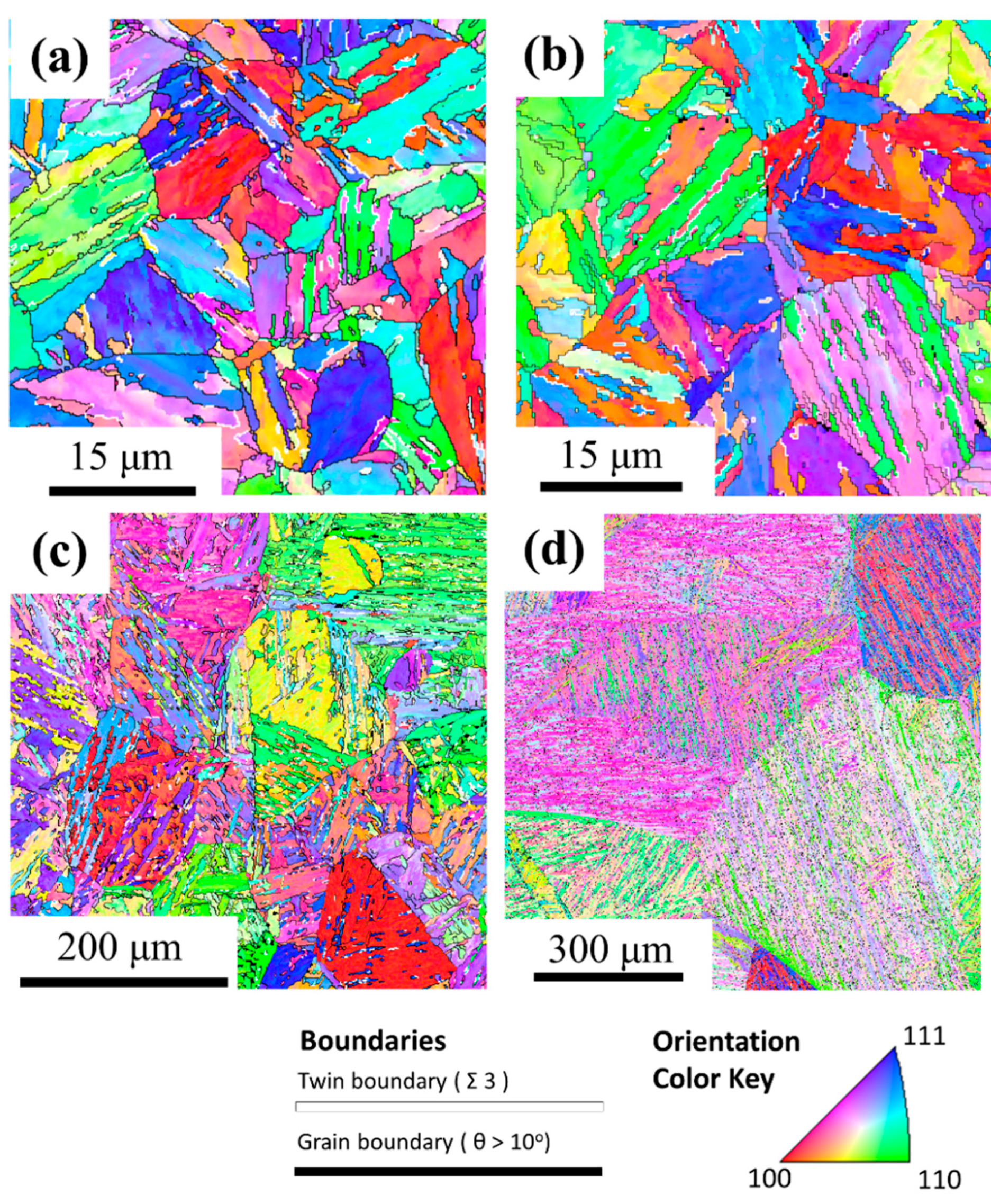

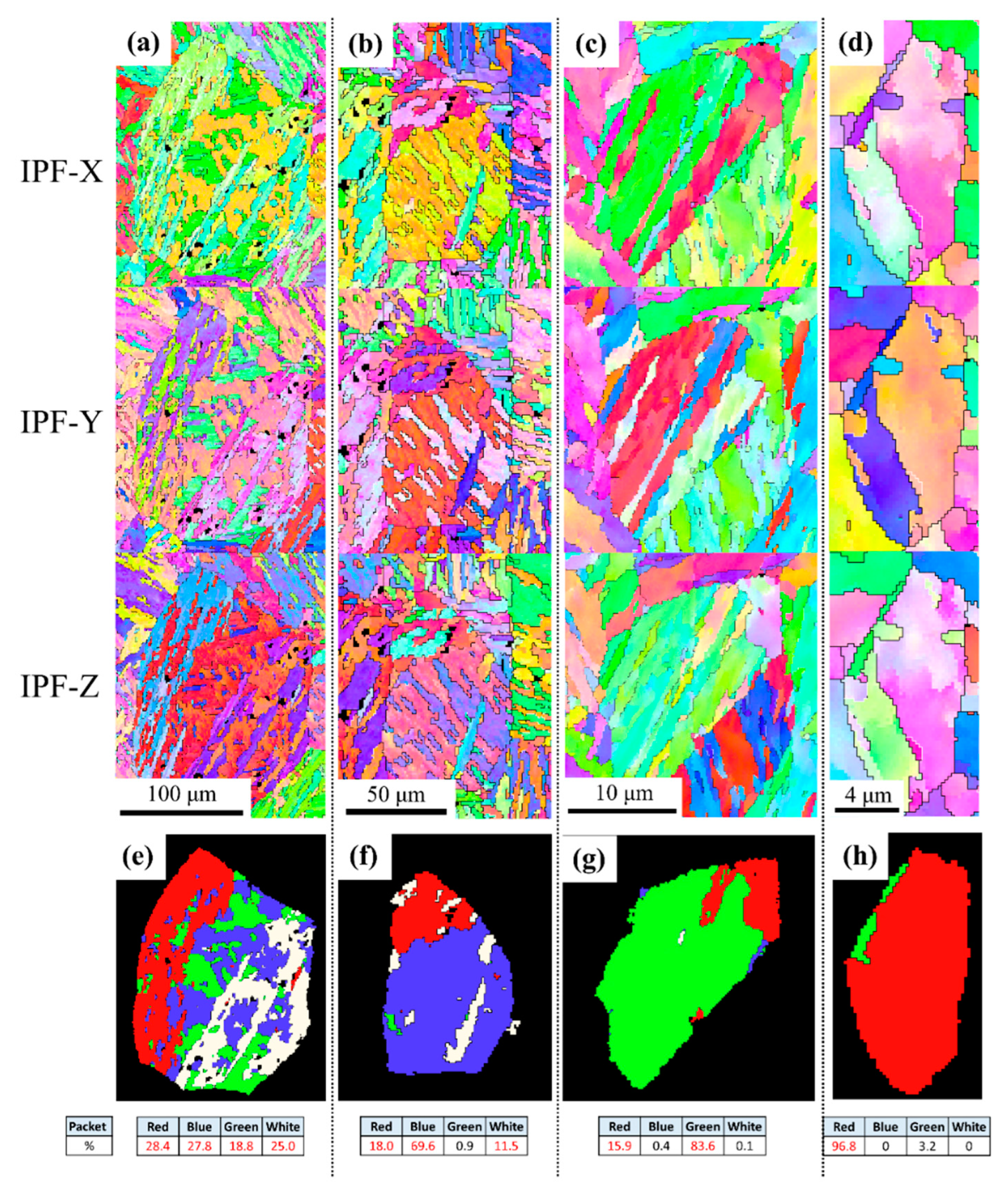
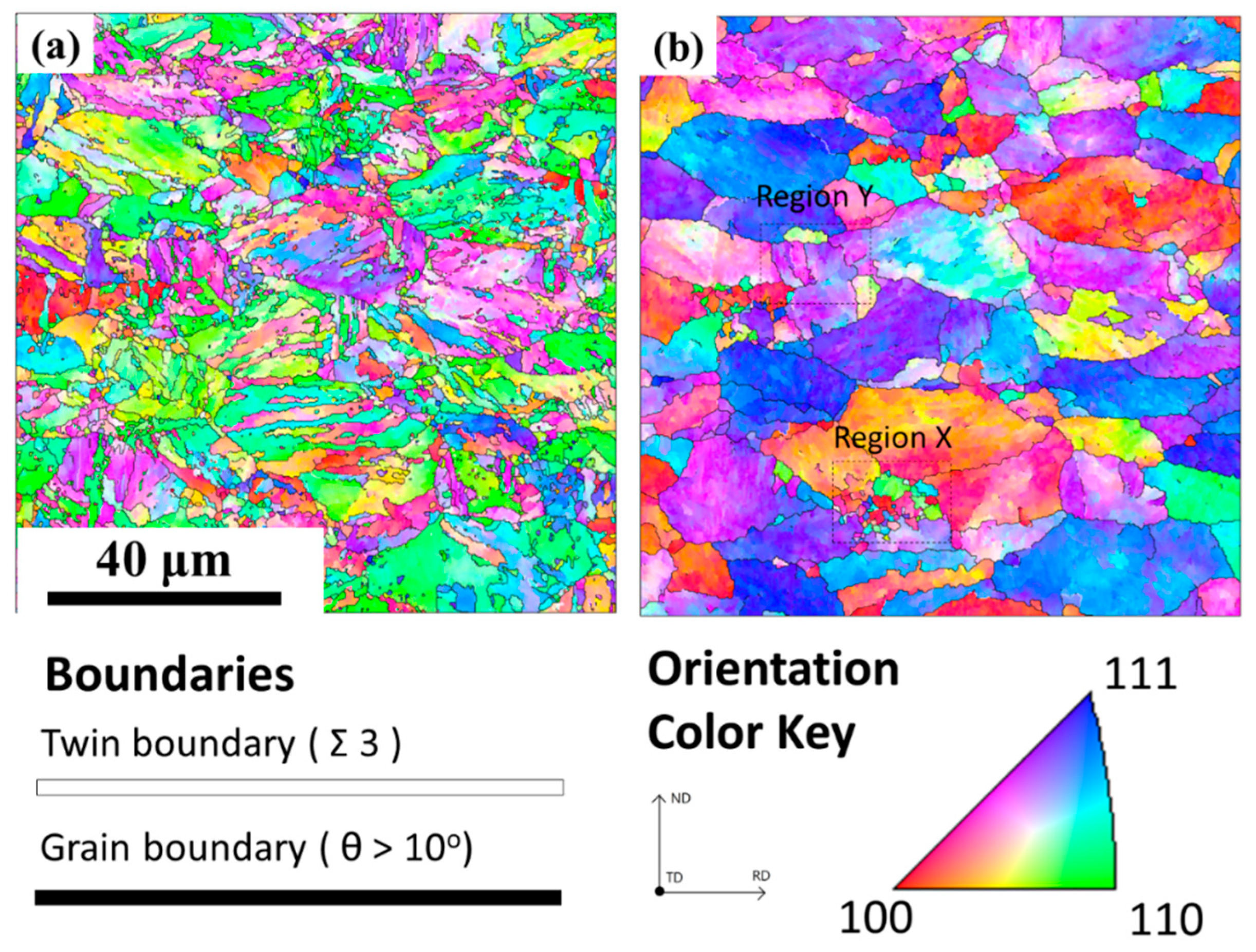


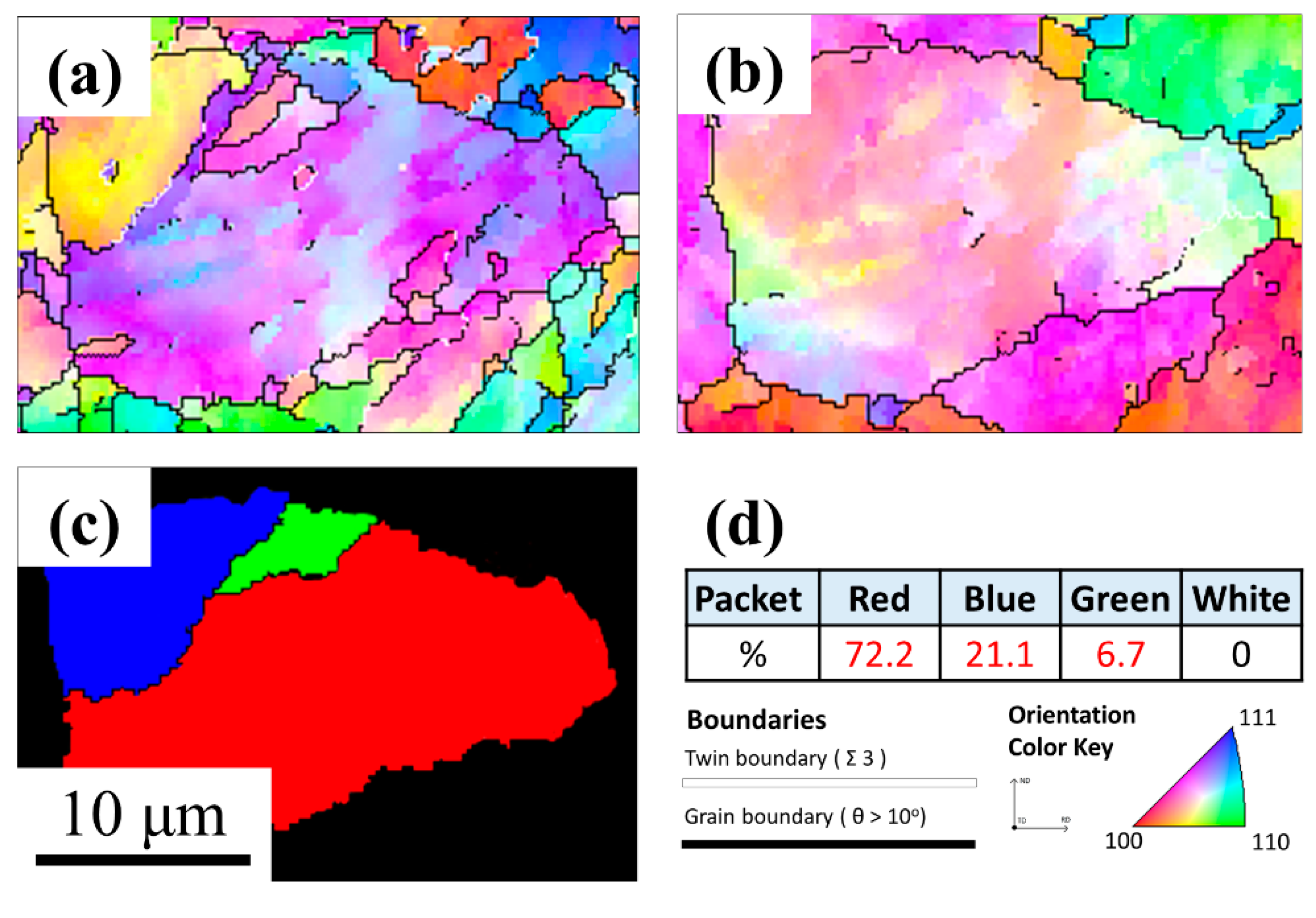
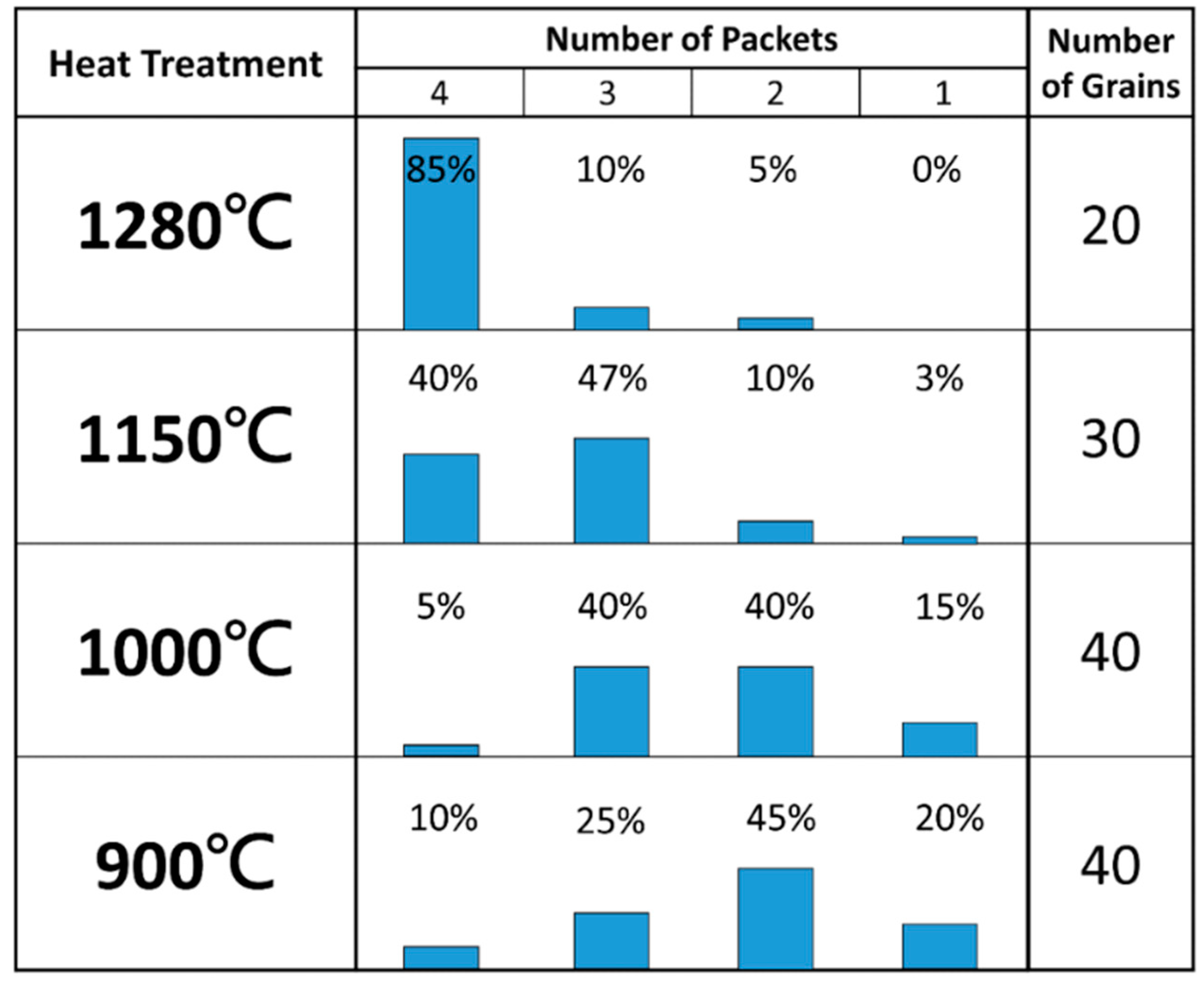
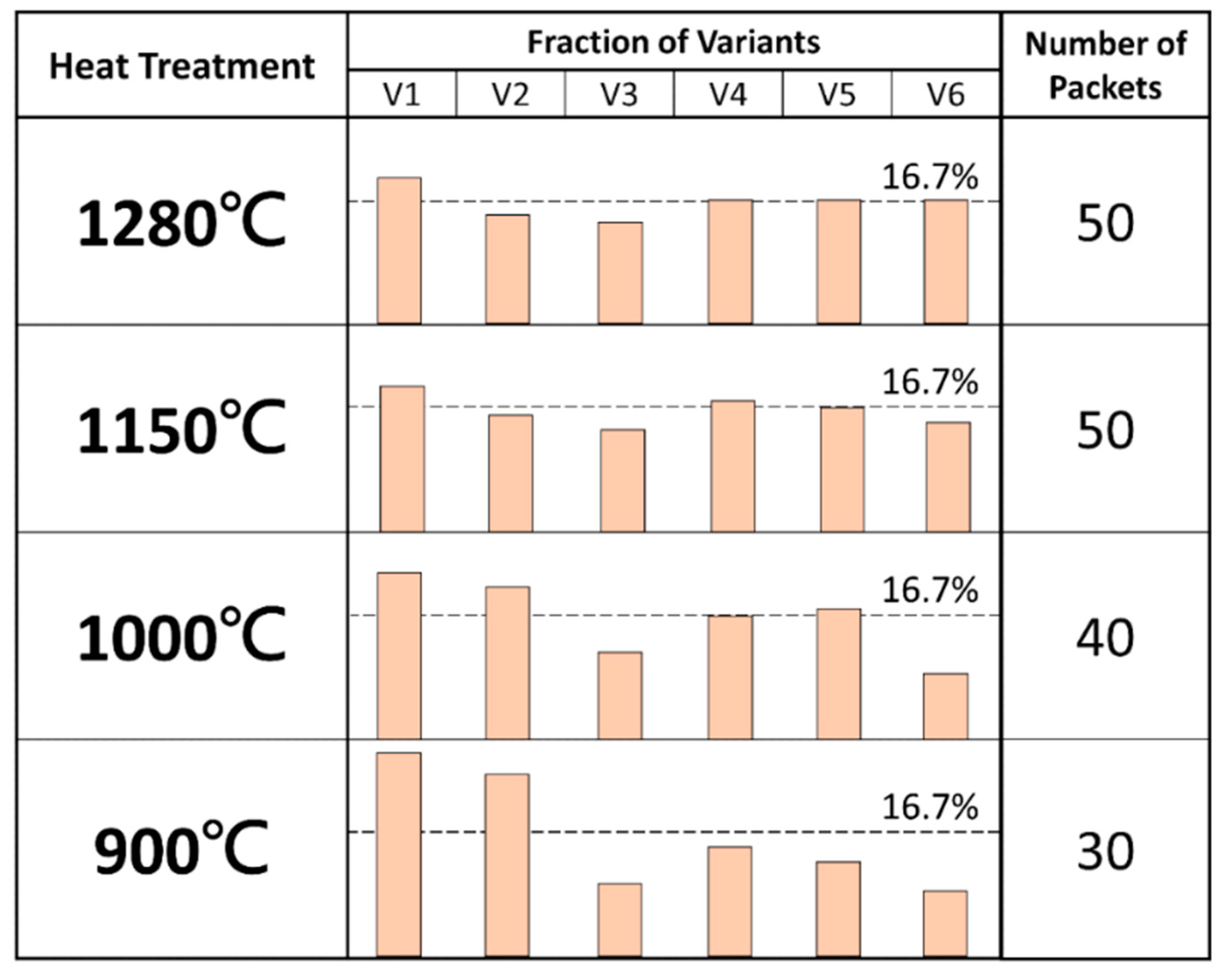
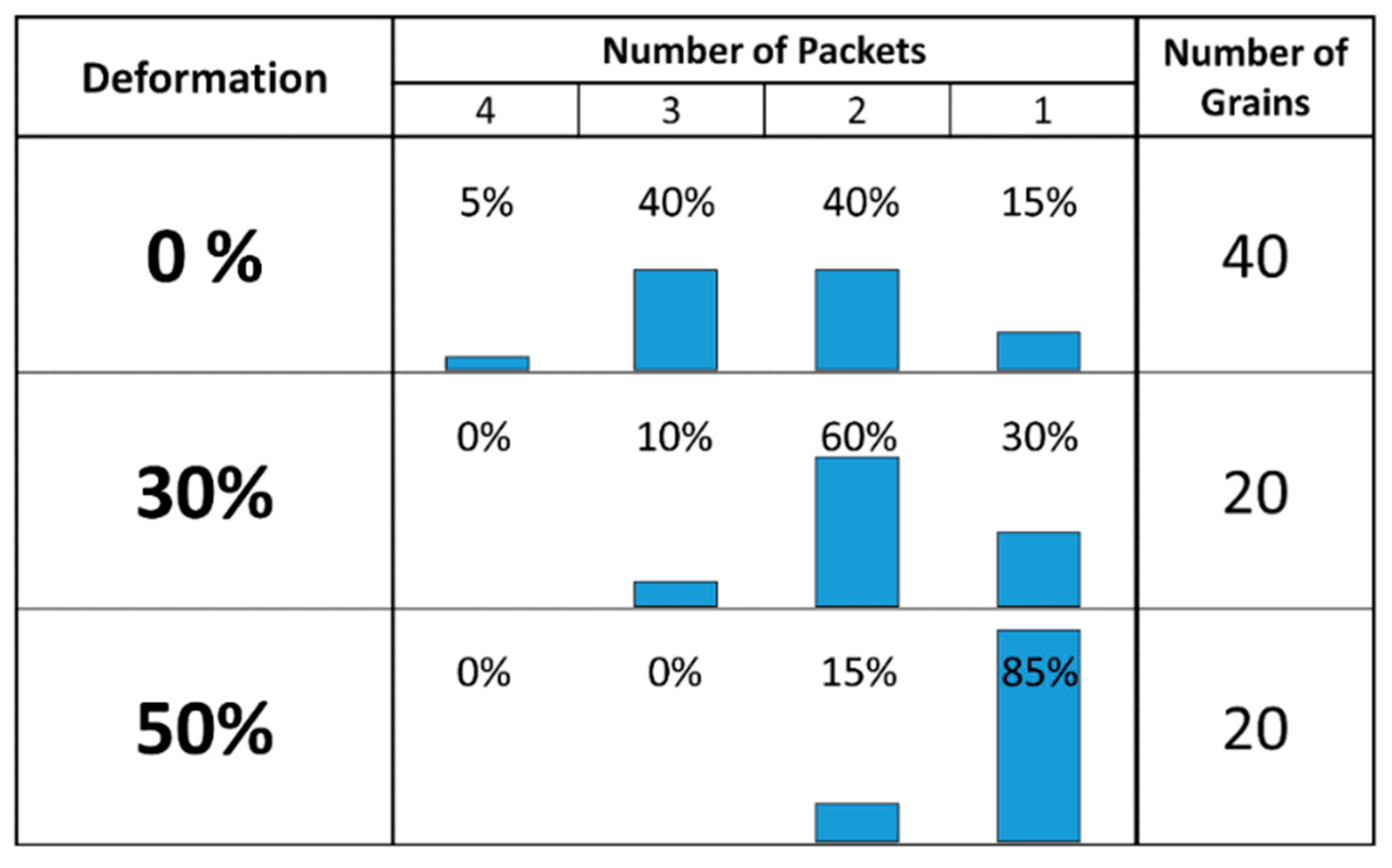
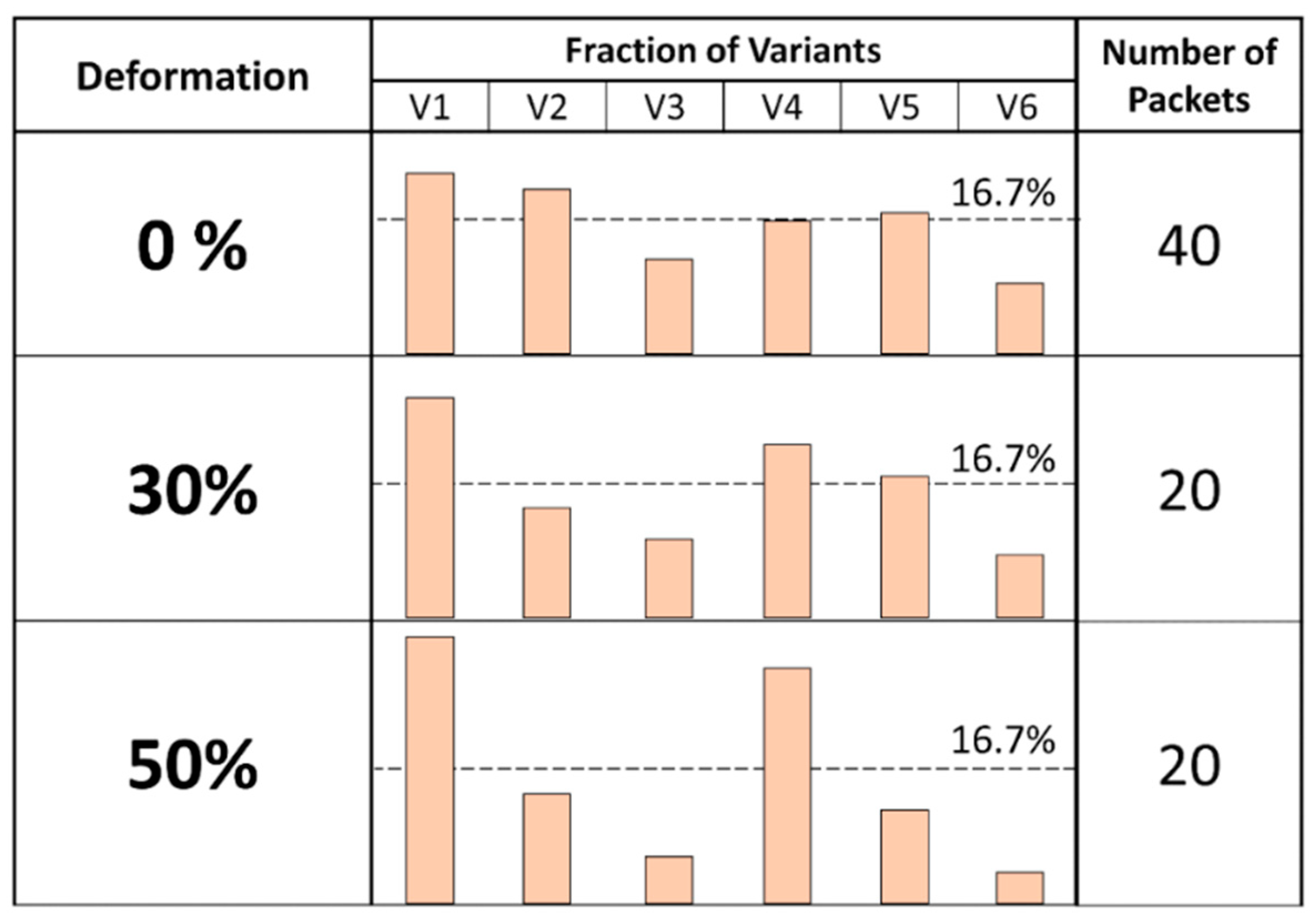
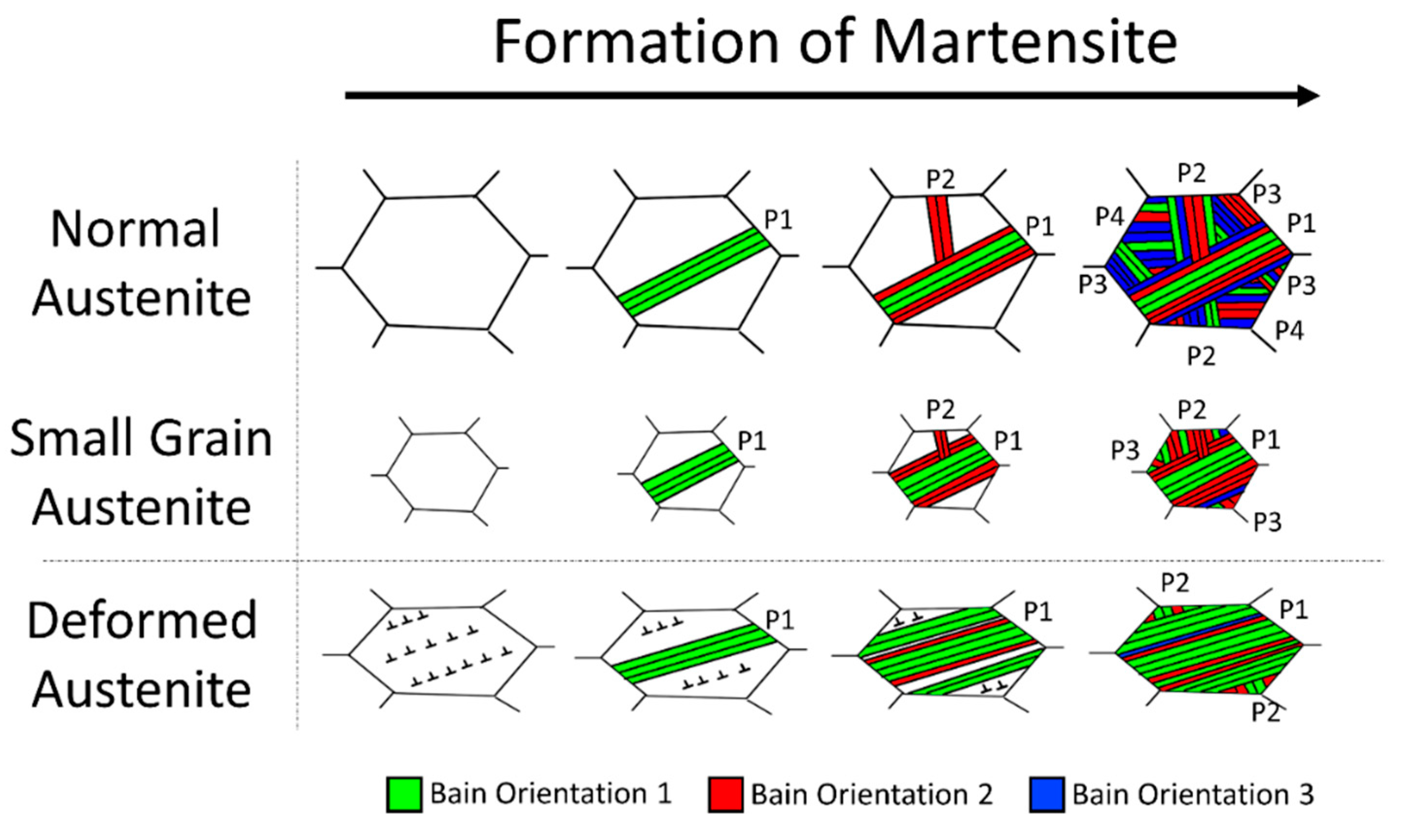
| Element | C | Ni | Cr | Co | Mo | Al | Mn | S | P | Fe |
|---|---|---|---|---|---|---|---|---|---|---|
| wt.% | <0.02 | 8.0 | 11.0 | 8.5 | 5.0 | 1.25 | <0.5 | <0.5 | <0.02 | Bal. |
| Condition | As-Received | 900 °C | 1000 °C | 1150 °C | 1280 °C |
|---|---|---|---|---|---|
| Grain size (μm) | - | 15.2 | 20.7 | 115.8 | >300 |
| Hardness (HV) | 246 | 352 ± 8 | 333 ± 20 | 262 ± 25 | 251 ± 19 |
Publisher’s Note: MDPI stays neutral with regard to jurisdictional claims in published maps and institutional affiliations. |
© 2022 by the authors. Licensee MDPI, Basel, Switzerland. This article is an open access article distributed under the terms and conditions of the Creative Commons Attribution (CC BY) license (https://creativecommons.org/licenses/by/4.0/).
Share and Cite
Huang, C.-Y.; Lu, S.-L.; Yen, H.-W. Digital Reconstruction of Engineered Austenite: Revisiting Effects of Grain Size and Ausforming on Variant Selection of Martensite. Metals 2022, 12, 1511. https://doi.org/10.3390/met12091511
Huang C-Y, Lu S-L, Yen H-W. Digital Reconstruction of Engineered Austenite: Revisiting Effects of Grain Size and Ausforming on Variant Selection of Martensite. Metals. 2022; 12(9):1511. https://doi.org/10.3390/met12091511
Chicago/Turabian StyleHuang, Cheng-Yao, Shao-Lun Lu, and Hung-Wei Yen. 2022. "Digital Reconstruction of Engineered Austenite: Revisiting Effects of Grain Size and Ausforming on Variant Selection of Martensite" Metals 12, no. 9: 1511. https://doi.org/10.3390/met12091511
APA StyleHuang, C.-Y., Lu, S.-L., & Yen, H.-W. (2022). Digital Reconstruction of Engineered Austenite: Revisiting Effects of Grain Size and Ausforming on Variant Selection of Martensite. Metals, 12(9), 1511. https://doi.org/10.3390/met12091511







